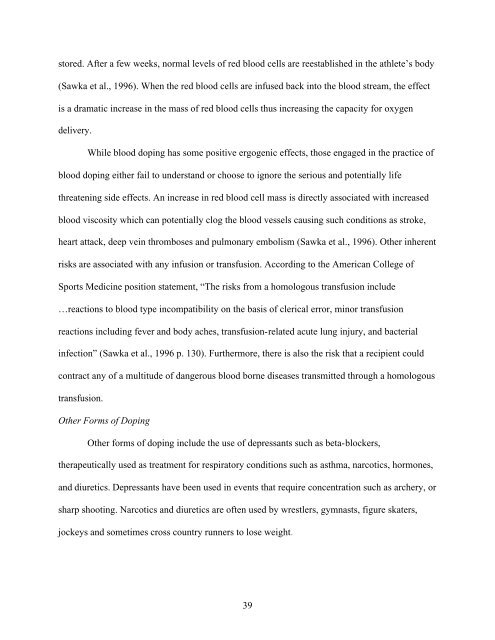the moral reasoning of student athletes and athletic training students
the moral reasoning of student athletes and athletic training students
the moral reasoning of student athletes and athletic training students
Create successful ePaper yourself
Turn your PDF publications into a flip-book with our unique Google optimized e-Paper software.
stored. After a few weeks, normal levels <strong>of</strong> red blood cells are reestablished in <strong>the</strong> athlete’s body<br />
(Sawka et al., 1996). When <strong>the</strong> red blood cells are infused back into <strong>the</strong> blood stream, <strong>the</strong> effect<br />
is a dramatic increase in <strong>the</strong> mass <strong>of</strong> red blood cells thus increasing <strong>the</strong> capacity for oxygen<br />
delivery.<br />
While blood doping has some positive ergogenic effects, those engaged in <strong>the</strong> practice <strong>of</strong><br />
blood doping ei<strong>the</strong>r fail to underst<strong>and</strong> or choose to ignore <strong>the</strong> serious <strong>and</strong> potentially life<br />
threatening side effects. An increase in red blood cell mass is directly associated with increased<br />
blood viscosity which can potentially clog <strong>the</strong> blood vessels causing such conditions as stroke,<br />
heart attack, deep vein thromboses <strong>and</strong> pulmonary embolism (Sawka et al., 1996). O<strong>the</strong>r inherent<br />
risks are associated with any infusion or transfusion. According to <strong>the</strong> American College <strong>of</strong><br />
Sports Medicine position statement, “The risks from a homologous transfusion include<br />
…reactions to blood type incompatibility on <strong>the</strong> basis <strong>of</strong> clerical error, minor transfusion<br />
reactions including fever <strong>and</strong> body aches, transfusion-related acute lung injury, <strong>and</strong> bacterial<br />
infection” (Sawka et al., 1996 p. 130). Fur<strong>the</strong>rmore, <strong>the</strong>re is also <strong>the</strong> risk that a recipient could<br />
contract any <strong>of</strong> a multitude <strong>of</strong> dangerous blood borne diseases transmitted through a homologous<br />
transfusion.<br />
O<strong>the</strong>r Forms <strong>of</strong> Doping<br />
O<strong>the</strong>r forms <strong>of</strong> doping include <strong>the</strong> use <strong>of</strong> depressants such as beta-blockers,<br />
<strong>the</strong>rapeutically used as treatment for respiratory conditions such as asthma, narcotics, hormones,<br />
<strong>and</strong> diuretics. Depressants have been used in events that require concentration such as archery, or<br />
sharp shooting. Narcotics <strong>and</strong> diuretics are <strong>of</strong>ten used by wrestlers, gymnasts, figure skaters,<br />
jockeys <strong>and</strong> sometimes cross country runners to lose weight.<br />
39

















